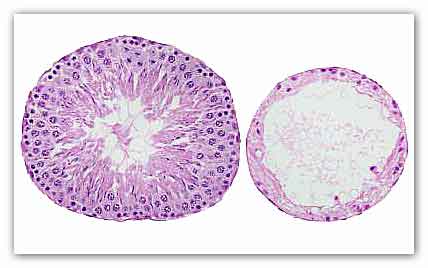|
The ideal male contraceptive would be inexpensive, reliable, and reversible. It would need to be long acting but have few side effects. New research published in BioMed Central's open access journal Reproductive Biology and Endocrinology used commercially available therapeutic ultrasound equipment to reduce sperm counts of male rats to levels which would result in infertility in humans.

IIMAGE Caption: The testis is composed of many tubes called "seminiferous tubules." The seminiferous tubule on the left is from a testis that was not treated with ultrasound while the tubule on the right is from a testis that was treated with ultrasound. Note that the tubule from the control testis has many darkly stained germ cell nuclei. Most germ cell nuclei are round; the long, thin nuclei closest to the center of the tubule belong to germ cells called spermatids and they will soon be released as testicular sperm. In contrast, the ultrasound-treated tubule is completely lacking testicular sperm and has lost almost all immature germ cells, decreasing its overall diameter while greatly increasing the amount of "empty" space in the center of the
tubule.
Credit: Image courtesy of James Tsuruta, Ph.D., and Paul Dayton, Ph.D.
Studies published in the 1970s by Mostafa S. Fahim and colleagues showed that a short treatment with ultrasound caused the depletion of germ cells and infertility.
The goal of the current study was to determine if a commercially available therapeutic ultrasound generator and transducer could be used as the basis for a male
contraceptive.
Rats were anesthetized and their testes were treated with 1 MHz or 3 MHz ultrasound while varying power, duration and temperature of treatment.
Researchers found that 3 MHz ultrasound delivered with 2.2 Watt per square cm power for fifteen minutes was necessary to deplete spermatocytes and spermatids from the testis and that this treatment significantly reduced epididymal sperm reserves. 3 MHz ultrasound treatment reduced total epididymal sperm count 10-fold lower than the wet-heat control and decreased motile sperm counts 1,000-fold lower than wet-heat alone.
The current treatment regimen provided nominally more energy to the treatment chamber than Fahim's originally reported conditions of 1 MHz ultrasound delivered at 1 Watt per square cm for ten minutes. However, the true spatial average intensity, effective radiating area and power output of the transducers used by Fahim were not reported, making a direct comparison impossible. We found that germ cell depletion was most uniform and effective when we rotated the therapeutic transducer to mitigate non-uniformity of the beam field.
The lowest sperm count was achieved when the coupling medium (3% saline) was held at 37 degrees C and two consecutive 15-minute treatments of 3 MHz ultrasound at 2.2 Watt per square cm were separated by 2 days.
The non-invasive nature of ultrasound and its efficacy in reducing sperm count make therapeutic ultrasound a promising candidate for a male contraceptive.
However, further studies must be conducted to confirm its efficacy in providing a contraceptive effect, to test the result of repeated use, to verify that the contraceptive effect is reversible and to demonstrate that there are no detrimental, long-term effects from using ultrasound as a method of male
contraception.
Authors
James K Tsuruta, Paul A Dayton, Caterina M Gallippi, Michael G O'Rand, Michael A Streicker, Ryan C Gessner, Thomas S Gregory, Erick JR Silva, Katherine G Hamil, Glenda J Moser and David C Sokal
Source
Reproductive Biology and Endocrinology
(MDN)
|
![]()